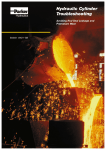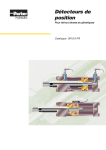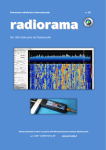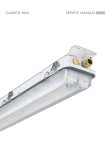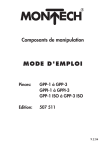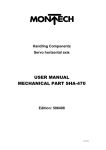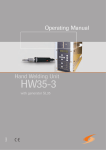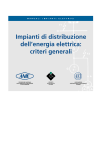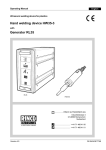Download Operating Instructions UCA Charging & Gauging Kit
Transcript
Bulletin HY07-1244 -T1/UK Hydraulics Operating Instructions UCA Charging & Gauging Kit Effective: 01 July 2001 For use with Piston, Bladder & Diaphragm Accumulators Bulletin HY07-1244-T1/UK Charging & Gauging Kit UCA Warning FAILURE OR IMPROPER SELECTION OR IMPROPER USE OF THE PRODUCTS AND/OR SYSTEMS DESCRIBED HEREIN OR RELATED ITEMS CAN CAUSE DEATH, PERSONAL INJURY AND PROPERTY DAMAGE. This document and other information from Parker Hannifin Corporation, its subsidiaries and authorized distributors provide product and/or system options for further investigation by users having technical expertise. It is important that all aspects of the application are analysed and the information concerning the product or system in the current product catalogue is reviewed. Due to the variety of operating conditions and applications for these products or systems, the user, through its own analysis and testing, is solely responsible for making the final selection of the products and systems and assuring that all performance, safety and warning requirements of the application are met. The products described herein, including without limitation, product features, specifications, designs, availability and pricing, are subject to change by Parker Hannifin Corporation and its subsidiaries at any time without notice. 2 Hydraulics Parker Hannifin plc Cylinder Division Watford, Herts. Bulletin HY07-1244 -T1/UK Introduction Charging & Gauging Kit UCA Description B The UCA universal charging & gauging kit is required to check the precharge pressure of an accumulator and to fill and vent the nitrogen. It is suitable for all Parker piston and bladder accumulators, and other commercially available accumulators with M28 x 1.5, 7/8-14 UNF, 5/8-18 UNF or 0.305-32 UNS (8V1-Vg 8) gas valves, operating up to a maximum working pressure of 340 bar. 6 10 5 8 The UCA assembly is screwed onto the accumulator’s gas valve and connected to the nitrogen source with the hose supplied. If the precharge pressure is only to be checked or reduced, the connection hose is not required. A 1 The standard charging and gauging kit is supplied in a case containing: 7 9 – a 'UCA' universal charging & gauging kit with M28 x 1.5 gas port connection M28 x 1.5 – two pressure gauges, 0-25 bar and 0-250 bar * – three adapters for connection to the accumulator gas valve (7/8 -14 UNF; 5/8 -18 UNF; 0.305-32 UNS) 2 – a 2.5m long hose, for connection to a nitrogen source 3 – a 6mm A/F hexagon wrench – a set of spare seals 5/8- 18 UNF * where a different pressure range is required, a commerciallyavailable pressure gauge may be used. 7/8 -14 UNF Safety 4 0.305 - 32 UNS (8V1-Vg 8) Charging must be carried out by qualified personnel. Figure 1 Universal Charging and Gauging Kit assembly Before taking any readings or pressurizing with nitrogen, the accumulator must be isolated from the hydraulic system and the fluid side discharged in order to depressurize it. Use only nitrogen (N2) to pressurize the accumulator. Controls A B Danger of Explosion – Never Charge with Oxygen Inflation valve Bleed valve Key 1 2 3 4 5 6 7 8 9 10 The types of nitrogen permitted are: type S (99.8% pure); type R (99.99% pure); type U (99.993% pure). If the pressure of the gas contained in the nitrogen bottle is greater than the maximum permissible operating pressure of the accumulator, a pressure regulator must be fitted to the nitrogen bottle. UCA Adapter (long) Adapter (short) Adapter (insert) Pressure gauge Knurled protective cap – gauge port Knurled collar – gas port Knurled protective cap – filling port Filling hose (G1/4 fitting, 60° cone) Filling port valve Parker recommends that the precharge should be checked during the first week following commissioning of the system. Thereafter, it should be checked after three months and then at intervals of 12 months or less, as considered appropriate by the system builder. The Effect of Temperature on Precharge Pressure In order to compensate for the difference in pressure at ambient and operating temperatures, it is recommended that the precharge pressure po should be adjusted to reflect the operating temperature of the system, using the correction factor equations and table on page 7. 3 Hydraulics Parker Hannifin plc Cylinder Division Watford, Herts. Charging & Gauging Kit UCA Bulletin HY07-1244-T1/UK Pressure Adjustment To Check and Adjust the Precharge Pressure 6 Warning – Stabilization The process of charging or discharging an accumulator with nitrogen causes a temperature change which is transmitted to the surrounding air as the temperature of the accumulator stabilizes. To allow for the effects of temperature transfer, the accumulator should be allowed to stand for a minimum of 15 minutes before a final reading of the precharge pressure is taken. Open the inflation valve (A) by screwing the handwheel clockwise until the inflation pressure registers on the gauge. Readings and Results One of three conditions will apply – the precharge pressure in the accumulator will be correct, or it will be too high or too low. Nitrogen Pressure po is Correct 1 Screw the handwheel (A) anti-clockwise to close the accumulator gas valve. Bladder or Piston Accumulators with Schrader-type Valve Figures 1, 2a & 2b Outer cap 11 2 Slacken the bleed valve (B) to release pressure in the UCA. 3 Unscrew the UCA from the adapter. 4 Unscrew the adapter(s) from the accumulator gas valve. Nitrogen Pressure po is Too High 1 Slacken the bleed valve (B) to vent nitrogen from the accumulator until, after stabilization, the desired pressure po is registered. Nitrogen vents into the air. Gas valve 13 Inner cap12 Figure 2a Bladder accumulator with Schrader-type gas valve Protective cover 14 2 Tighten the bleed valve (B) once the desired filling pressure is reached. 3 Screw the handwheel (A) anti-clockwise to close the accumulator gas valve. 4 Slacken the bleed valve (B) to release pressure in the UCA. 5 Unscrew the UCA from the adapter. 6 Unscrew the adapter(s) from the accumulator gas valve. Gas valve cap 15 Nitrogen Pressure po is Too Low 1 Close the inflation valve (A) by screwing the handwheel anti-clockwise.. Gas valve 16 2 Remove the knurled cap on the filling port (8). 3 Connect the end of the filling hose (9) to the filling port valve (10). 4 Connect the other end of the hose to the nitrogen source. 5 Progressively open the valve on the nitrogen source. 6 Screw the handwheel (A) clockwise to admit the pressurized gas, taking particular care if the accumulator has a small capacity or is of the low pressure type ( < 40 bar). 7 When pressure po is reached, close the valve on the nitrogen source. To allow for the effects of temperature transfer, the accumulator should be allowed to stand for a minimum of 15 minutes to allow the temperature to stabilize before a final reading of the precharge pressure is taken. 8 Screw the handwheel (A) anti-clockwise to close the accumulator gas valve. 9 Slacken the bleed valve (B) to release pressure in the UCA. Figure 2b Piston accumulator with Schrader-type gas valve 1 Unscrew the caps (11 and 12) from a bladder accumulator or the protective cover and cap (14 and 15) from a piston accumulator, to gain access to the gas valve (13 or 16). 2 Select the appropriate pressure gauge (5) for the pressure to be checked, remove the protective cap (6) and attach the gauge to the UCA (1). 3 4 5 Make sure that the bleed valve (B) is fully closed and that the inflation valve (A) is in the fully raised position by turning the handwheel in an anti-clockwise direction. 10 Remove the hose carefully, to release internal pressure. Bladder accumulators: Ensure that the o-ring is correctly positioned in the base of the long adapter (2), screw the adapter on to the gas valve (13) and hand tighten. Piston accumulators: Assemble the short adapter and adapter insert (3 and 4), screw onto the gas valve (16) and hand tighten. 11 Refit the knurled cap (8) to the filling port valve (10). 12 Unscrew the UCA from the adapter(s). 13 Unscrew the adapter(s) from the accumulator gas valve. After removing the UCA and adapter(s), make sure that the accumulator gas valve (13 or 16) is sealing effectively. Refit the protective cap(s) (11, 12, 15) and cover (14), where applicable. Screw the UCA onto the adapter. Position the assembly to permit easy reading of the gauge, then hand tighten the knurled collar (7). 4 Hydraulics Parker Hannifin plc Cylinder Division Watford, Herts. Charging & Gauging Kit UCA Bulletin HY07-1244 -T1/UK Pressure Adjustment Piston Accumulators with Poppet-type Valve Figures 1 & 3 Nitrogen Pressure po is Too High 1 Slacken the bleed valve (B) to vent nitrogen from the accumulator until, after stabilization, the desired pressure po is registered. Nitrogen vents into the air. 1 Unscrew the protective cover (17), where fitted, and cap (18) from the accumulator gas valve (19). 2 Assemble the short adapter and adapter insert (3 and 4), and screw onto the accumulator gas valve. 2 Tighten the bleed valve (B) once the desired filling pressure is reached. 3 Select the appropriate pressure gauge (5) for the pressure to be checked, remove the protective cap (6) and attach the gauge to the UCA (1). Make sure that the bleed valve (B) is fully closed. The position of inflation valve (A) can be ignored, as it does not affect this procedure. 3 Close the accumulator gas valve by screwing the adjuster nut (20) clockwise.. 4 Screw the UCA onto the adapter. Position the assembly to permit easy reading of the gauge, then hand tighten the knurled collar (7). 5 Open the accumulator gas valve by turning the hexagonal poppet valve adjuster nut (20) anti-clockwise until the inflation pressure registers on the gauge. 4 Slacken the bleed valve (B) to release pressure in the UCA. 5 Unscrew the UCA from the adapter. 6 Unscrew the adapter (3) and adapter insert (4) from the accumulator gas valve (19). Nitrogen Pressure po is Too Low 1 Close the accumulator gas valve by screwing the poppet valve adjuster nut (20) clockwise.. Note: for 360mm bore accumulators, a 19mm A/F spanner approximately 120mm long should be used to turn the valve adjuster nut (20). Protective cover 17 Protective cap 18 2 Remove the knurled cap on the filling port (8). 3 Connect the end of the filling hose (9) to the filling port valve (10). 4 Connect the other end of the hose to the nitrogen source. 5 Progressively open the valve on the nitrogen source. 6 Open the accumulator gas valve by screwing the adjuster nut (20) anti-clockwise, to admit the pressurized gas, taking particular care if the accumulator has a small capacity or is of the low pressure type ( < 40 bar). 7 When pressure po is reached, close the valve on the nitrogen source. To allow for the effects of temperature transfer, the accumulator should be allowed to stand for a minimum of 15 minutes to allow the temperature to stabilize before a final reading of the precharge pressure is taken. 8 Close the accumulator gas valve by screwing the adjuster nut (20) clockwise.. 9 Slacken the bleed valve (B) to release pressure in the UCA. Gas valve 19 Adjuster nut 20 10 Remove the hose (9) carefully, to release internal pressure. Figure 3 Poppet-type accumulator gas valve 11 Refit the knurled cap (8) to the filling port valve (10). Readings and Results One of three conditions will apply – the precharge pressure in the accumulator will be correct, or it will be too high or too low. 12 Unscrew the UCA from the adapter. 13 Unscrew the adapter (3) and adapter insert (4) from the accumulator gas valve (19). Nitrogen Pressure po is Correct 1 Close the accumulator gas valve by turning the poppet valve adjuster nut (20) clockwise. 2 Slacken the bleed valve (B) to release pressure in the UCA. 3 Unscrew the UCA from the adapter. 4 Unscrew the adapter (3) and adapter insert (4) from the accumulator gas valve (19). After removing the UCA and adapters, make sure that the accumulator gas valve is sealing effectively. Refit the protective cap (18) and protective cover (17) to the accumulator gas valve (19). 5 Hydraulics Parker Hannifin plc Cylinder Division Watford, Herts. Charging & Gauging Kit UCA Bulletin HY07-1244-T1/UK Pressure Adjustment Diaphragm Accumulators Figures 1 & 4 Nitrogen Pressure po is Too High 1 Slacken the bleed valve (B) to vent nitrogen from the accumulator until, after stabilization, the desired pressure po is registered. Nitrogen vents into the air. The following instructions apply only to diaphragm accumulators fitted with a socket-headed screw type gas valve, as illustrated in Figure 4. 2 Tighten the bleed valve (B) once the desired filling pressure is reached. 3 Screw the handwheel (A) clockwise to close the accumulator gas valve. 4 Slacken the bleed valve (B) to release pressure in the UCA. 5 Unscrew the UCA from the accumulator gas valve. 6 Using the 6mm hexagon wrench supplied, ensure that the hexagon socket-headed gas valve screw (22) is firmly tightened. Refit the protective cap (21) to the accumulator gas valve. Cap 21 Gas valve socket-headed screw 22 Figure 4 Diaphragm accumulator with socket-headed screw gas valve Danger – do not attempt to loosen the gas valve screw with a hexagon wrench, as it could be ejected under extreme pressure Nitrogen Pressure po is Too Low 1 Close the inflation valve (A) by screwing the handwheel clockwise. 2 Remove the knurled cap (8) on the filling port. 3 Connect the end of the filling hose (9) to the filling port valve (10). 4 Connect the other end of the hose to the nitrogen source. 5 Progressively open the valve on the nitrogen source. 6 Screw the handwheel (A) anti-clockwise to admit the pressurized gas, taking particular care if the accumulator has a small capacity or is of the low pressure type (< 40 bar). 7 When pressure po is reached, close the valve on the nitrogen source. To allow for the effects of temperature transfer, the accumulator should be allowed to stand for a minimum of 15 minutes to allow the temperature to stabilize before a final reading of the precharge pressure is taken. 8 Screw the handwheel (A) clockwise to close the accumulator gas valve. One of three conditions will apply – the precharge pressure in the accumulator will be correct, or it will be too high or too low. 9 Slacken the bleed valve (B) to release pressure in the UCA. Nitrogen Pressure po is Correct 1 Screw the handwheel (A) clockwise to close the accumulator gas valve. 11 Refit the knurled cap (8) to the filling port valve (10). 1 Select the appropriate pressure gauge (5) for the pressure to be checked, remove the protective cap (6) and attach the gauge to the UCA (1). Make sure that the bleed valve (B) is fully closed. 2 Unscrew the cap (21) from the accumulator gas valve. Release, but do not loosen, the socket-headed gas valve screw (22) using the 6mm hexagon wrench supplied. 3 4 Screw the knurled collar (7) on the base of the UCA (1) onto the accumulator gas valve. Ensure that the male hexagon in the base of the UCA engages with the female hexagon in the accumulator gas valve (22). Open the inflation valve (A) by screwing the handwheel anti-clockwise until the inflation pressure registers on the gauge. Readings and Results 2 Slacken the bleed valve (B) to release pressure in the UCA. 3 Unscrew the UCA from the accumulator gas valve. 4 Using the 6mm hexagon wrench supplied, ensure that the hexagon socket-headed gas valve screw (22) is firmly tightened. Refit the protective cap (21) to the accumulator gas valve. 10 Remove the hose carefully, to release internal pressure. 12 Unscrew the UCA from the accumulator gas valve. 13 Using the 6mm hexagon wrench supplied, ensure that the hexagon socket-headed gas valve screw (22) is firmly tightened. Refit the protective cap (21) to the accumulator gas valve. 6 Hydraulics Parker Hannifin plc Cylinder Division Watford, Herts. Charging & Gauging Kit UCA Bulletin HY07-1244-T1/UK Correction Factors Calculation of Correction Factors at Full Pressure where: p0 (t2) = precharge pressure at working temperature t2 p0 (t0) = precharge pressure at precharge temperature t0 t + 273 p0 (t 0 ) = p0 (t 2 ) 0 = p0 (t 2 ) × K t 2 + 273 Operating Temperature t2 °C Table of Correction Factors K = correction factor Precharge Temperature t0 °C -20 -10 0 5 10 15 20 25 30 35 40 50 60 70 80 90 100 -20 1.00 1.04 1.08 1.10 1.12 1.14 1.16 1.18 1.20 1.22 1.24 1.28 1.32 1.36 1.40 1.43 1.47 -10 0.96 1.00 1.04 1.06 1.08 1.10 1.11 1.13 1.15 1.17 1.19 1.23 1.27 1.30 1.34 1.38 1.42 0 0.93 0.96 1.00 1.02 1.04 1.05 1.07 1.09 1.11 1.13 1.15 1.18 1.22 1.26 1.29 1.33 1.37 10 0.89 0.93 0.96 0.98 1.00 1.02 1.04 1.05 1.07 1.09 1.11 1.14 1.18 1.21 1.25 1.28 1.32 20 0.86 0.90 0.93 0.95 0.97 0.98 1.00 1.02 1.03 1.05 1.07 1.10 1.14 1.17 1.20 1.24 1.27 30 0.84 0.87 0.90 0.92 0.93 0.95 0.97 0.98 1.00 1.02 1.03 1.07 1.10 1.13 1.16 1.20 1.23 40 0.81 0.84 0.87 0.89 0.90 0.92 0.94 0.95 0.97 0.98 1.00 1.03 1.06 1.10 1.13 1.16 1.19 50 0.78 0.81 0.85 0.86 0.88 0.89 0.91 0.92 0.94 0.95 0.97 1.00 1.03 1.06 1.09 1.12 1.15 60 0.76 0.79 0.82 0.83 0.85 0.86 0.88 0.89 0.91 0.92 0.94 0.97 1.00 1.03 1.06 1.09 1.12 70 0.74 0.77 0.80 0.81 0.83 0.84 0.85 0.87 0.88 0.90 0.91 0.94 0.97 1.00 1.03 1.06 1.09 80 0.72 0.75 0.77 0.79 0.80 0.82 0.83 0.84 0.86 0.87 0.89 0.92 0.94 0.97 1.00 1.03 1.06 90 0.70 0.72 0.75 0.77 0.78 0.79 0.81 0.82 0.83 0.85 0.86 0.89 0.92 0.94 0.97 1.00 1.03 100 0.68 0.71 0.73 0.75 0.76 0.77 0.79 0.80 0.81 0.83 0.84 0.87 0.89 0.92 0.95 0.97 1.00 110 0.66 0.69 0.71 0.73 0.74 0.75 0.77 0.78 0.79 0.80 0.82 0.84 0.87 0.90 0.92 0.95 0.97 120 0.64 0.67 0.69 0.71 0.72 0.73 0.75 0.76 0.77 0.78 0.80 0.82 0.85 0.87 0.90 0.92 0.95 Example Warning – Stabilization Satisfactory system operation requires a precharge pressure of 100 bar. The operating temperature t2 is 50°C and the temperature at precharging t0 is 20°C. From the table, a correction factor of 0.91 should be applied, giving a precharge pressure at 20°C of 91 bar. The process of filling or discharging an accumulator with nitrogen causes a temperature change which is transmitted to the surrounding air as the temperature of the accumulator stabilizes. To allow for the effects of temperature transfer, the accumulator should be allowed to stand for a minimum of 15 minutes to allow the temperature to stabilize before a final reading of the precharge pressure is taken. Gas Bottle Fittings and Part Numbers To meet the requirements of different markets, Parker’s UCA Charging and Gauging Kits are supplied with an adapter to suit the appropriate gas bottle fitting. Country Gas Bottle Fitting Part No. UK 5/8 BSP (male) UCA 02 France W 21.7 x 1/14" (female) UCA 04 Germany W 24.32 x 1/14" (female) UCA 01 Italy W 21.7 x 1/14" (male) UCA 05 US 0,960 x 1/14" (male) UCA 03 Technical Specification Maximum pressure Accumulator connection UCA – nitrogen bottle hose Nitrogen bottle connection Pressure gauges 7 Hydraulics 340 bar 7/8-14 UNF, 5/8-18 UNF, 0.305-32 UNS, M28 x 1.5 2.5m long approx. 5/8" BSP with o-ring seal (UK: part no. UCA 02) Two 63mm dia. glycerine-bath type, 0-25 and 0-250 bar ±1.6% Parker Hannifin plc Cylinder Division Watford, Herts. Cylinder Division Sales Offices Austria – Marchtrenk Parker Hannifin GmbH Tel: (7242) 56921 Fax: (7242) 5692120 Norway – Langhus Parker Hannifin A/S Tel: 64 91 10 00 Fax: 64 91 10 90 Belgium – Brussels Parker Hannifin SA NV Tel: 67 280 900 Fax: 67 280 999 Poland – Warsaw Parker Hannifin Corp. Tel: (22) 863 49 42 Fax: (22) 863 49 44 Czech Republic – Prague Parker Hannifin Corporation Tel: (02) 830 85 221 Fax: (02) 830 85 360 Portugal – Leca da Palmeira Parker Hannifin Portugal Lda. Tel: (22) 999 7360 Fax: (22) 996 1527 Denmark – Ishøj Parker Hannifin Danmark A/S Tel: 43 56 04 00 Fax: 43 73 31 07 Slovakia Ref. Czech Republic Finland – Vantaa Parker Hannifin Oy Tel: 9 476 731 Fax: 9 476 73200 France – Contamine-sur-Arve Parker Hannifin SA Tel: 4 50 25.80.25 Fax: 4 50 03.67.37 Germany – Cologne Parker Hannifin GmbH Tel: (221) 71720 Fax: (221) 7172219 Hungary – Budapest Parker Hannifin Corp. Tel + Fax: 1 252 2539 Need a Parker part? Call Parker's European Product Information Centre on 00800 27 27 5374 Visit us at www.parker.com Hydraulics Italy – Arsago-Seprio Parker Hannifin S.p.A. Tel: (0331) 765611 Fax: (0331) 765612 Spain – Madrid Parker Hannifin Espana S.A. Tel: (91) 675 73 00 Fax: (91) 675 77 11 Sweden – Spånga Parker Hannifin AB. Tel: 08 5979 50 00 Fax: 08 5979 51 20 Switzerland – Romanshorn Hydrel A.G. Romanshorn Tel: (714) 66 66 66 Fax: (714) 66 63 33 Turkey – Istanbul Hidroser Hidrolik - Pnömatik Tel: (212) 886 72 70 Fax: (212) 886 69 35 United Kingdom – Watford Parker Hannifin Plc Tel: (01923) 492000 Fax: (01923) 248557 Netherlands – Oldenzaal Parker Hannifin B.V. Tel: (0541) 585000 Fax: (0541) 585459 1244-T1/UK 2M CP 0701








